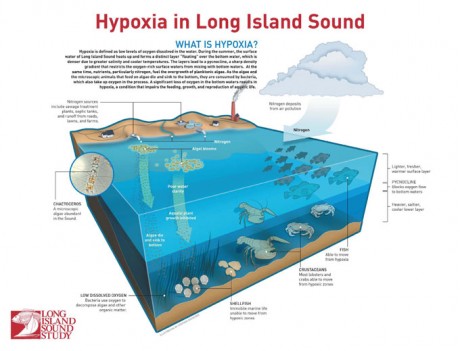Hypoxia and its Effect on Wildlife
When a body of water becomes hypoxic, it lacks sufficient dissolved oxygen for some marine species. Tom Andersen, New York Program and Communications Coordinator for Save the Sound, recently asked Dr. K a question about hypoxia’s impact on fish and other wildlife in the Sound.
Q: We’ve seen the CT DEEP (Connecticut Department of Energy and Environmental Protection) analysis of how fish biomass falls as hypoxia falls. Are there other ways in which hypoxia has been affecting the abundance of wildlife in Long Island Sound, either short-term or long-term?
Dr. K:
In regards to your question about fish biomass and hypoxia, this is a very tricky question. The direct impacts of hypoxia on finfish biomass are pretty well understood. Most fish are able to swim away from an area with undesirably low oxygen. EPA’s criteria, which is based on a great deal of scientific information, is that sub-lethal effects begin at around 4.8mg/l, and lethal effects (for organisms unable to escape) around 2.3mg/l (for more information see: http://water.epa.gov/scitech/swguidance/standards/criteria/aqlife/dissolved/dofacts.cfm). Of course, these numbers are somewhat variable by species; in general (but not always) more mobile pelagic fish (such as bluefish and striped bass) have less tolerance for hypoxia than stationary fish that tend to hang out on the bottom (e.g. flounder). This is a problem for the mobile fish if they are unable to swim away from the impacted area. The impact of episodic hypoxia, or hypoxic events between 4.8 and 2.3mg/l is more complex, and tends to vary much more from species to species. In addition, there are a number of less well understood indirect effects that can result from hypoxia, such as loss of feeding grounds or prey. Penny Howell, Kurt Gottschall and colleagues at CT DEEP have spent a great deal of time and effort studying the impacts of oxygen on fish, and have derived an index called BADD (for Biomass Area Depletion Days) that estimates the impact on fish habitat of hypoxia. Our outreach team is working with them to turn this index into an environmental indicator to use on our website here: http://water.epa.gov/scitech/swguidance/standards/criteria/aqlife/dissolved/dofacts.cfm, so stay tuned for that in the coming months.
Where it really gets complicated is that some of the drivers of hypoxia, such as nutrient levels, are actually positive drivers of fish growth. In the absence of hypoxia concerns, more nutrients means more phytoplankton, which means more zooplankton, which means more food for fish, which generally means more fish. We are now in the early stages of our management actions to reduce nutrient loadings with the long term goal of reducing hypoxia, and therefore making LIS better habitat for fish. However, based on other systems which have taken similar management actions, we expect it to take up to 5-10 years for the system to reach equilibrium and for noticeable reductions in hypoxia to be observed. In the interim, we may see a reduction in fish population resulting from increased competition for limited food resources.
However, this is further complicated by pressures on the fisheries which have little or nothing to do with hypoxia. Climate change is drastically changing the species assemblage of fish communities up and down the east coast, and Long Island Sound is no exception. Boreal species such as winter flounder and lobster are being replaced with temperate species like blue crab and weakfish. In some systems the niche filled by highly desirable commercial fish species is being filled by skates and dogfish, which have little commercial value, but are preventing the more desirable species from recovering from overfishing. Invasive species including Asian shore crabs and tunicates (a type of sea squirt) are out competing native species for food and habitat resources, and are not preferred prey for commercially harvested fish species. These impacts make it difficult to tell for certain whether observed changes in fish abundance are driven by changes in hypoxic area/duration, or by other factors, or most likely, a combination of both.
So I guess the answer to your question is yes. There are many ways that hypoxia both directly and indirectly impacts fish populations. Furthermore, many of the drivers of hypoxia (such as nutrient loading and climate change) can also impact fish populations. It can be very difficult to tease apart these impacts from sparse fisheries independent trawl data (such as the CT DEEP survey and the NOAA spring and fall trawl surveys on which I just participated- see my last blog post), so what we need is to invest more time and effort in collaborative research work with the fishing industry, To try to bring as much information as possible to the table so we can make informed management decisions.
 Jason Krumholz, aka Dr., K, is the NOAA liaison to EPA’s Long Island Sound Office. Dr. Krumholz received his doctorate in oceanography at the University of Rhode Island Graduate School of Oceanography.
Jason Krumholz, aka Dr., K, is the NOAA liaison to EPA’s Long Island Sound Office. Dr. Krumholz received his doctorate in oceanography at the University of Rhode Island Graduate School of Oceanography.
Have a Sound Health question?
ASK DR. K!
Send an e-mail to Jason Krumholz.. Dr. Krumholz is a marine scientist working as the NOAA liaison to the EPA Long Island Sound Office. View more of Dr. K’s questions and answers on the Ask Dr. K blog.
Editor’s Note: The opinions expressed in this blog are those of the author. They do not reflect EPA or NOAA policy, endorsement, or action, and EPA or NOAA do not verify the accuracy or science of the contents of the blog.
